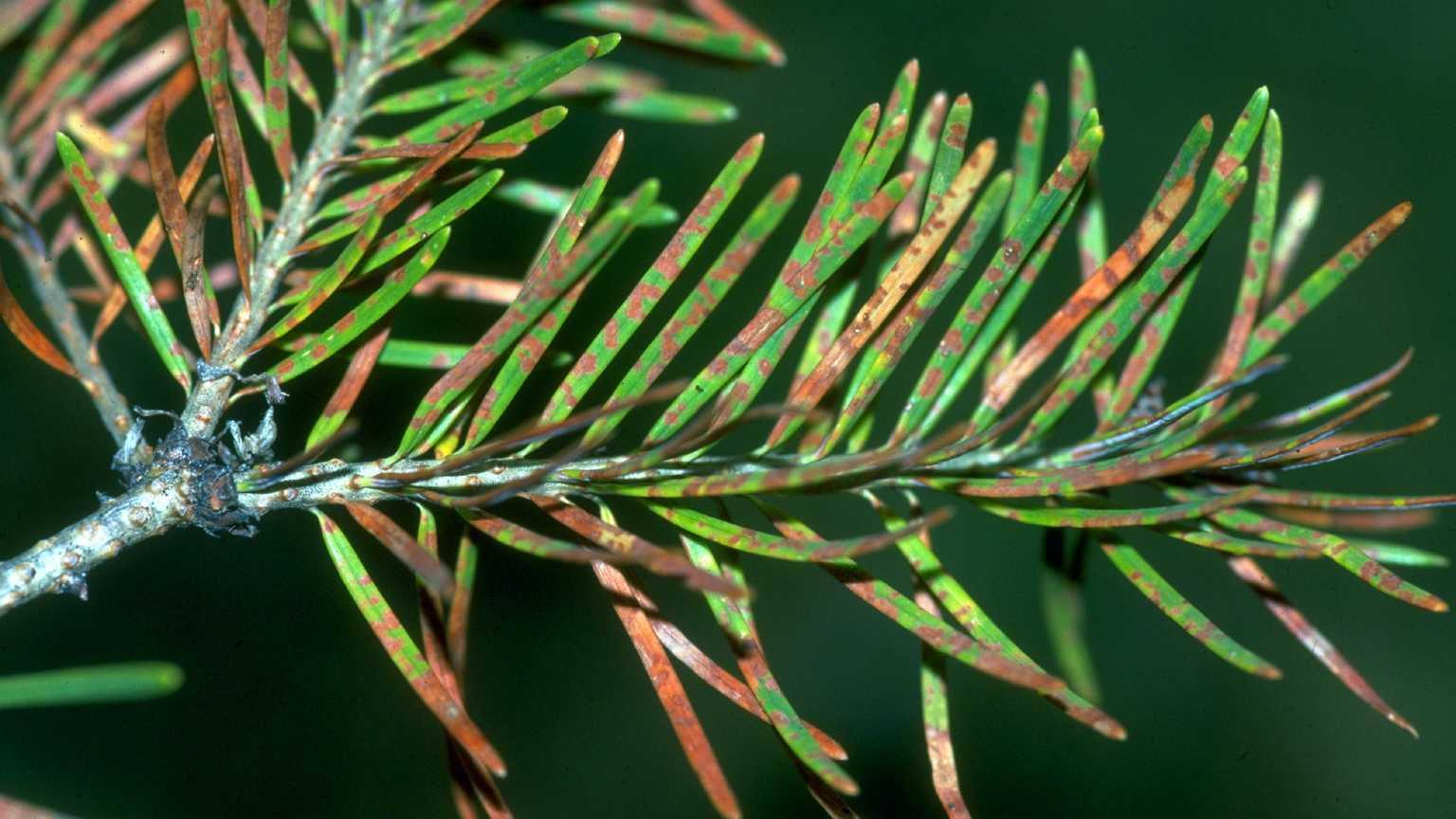Key points
- Needle cast diseases are caused by various fungi that infect the new needles on pines, spruce, Douglas fir, and true fir.
- Although the needles become infected, symptoms of the disease often are not visible until the following winter or spring season.
- Infected needles may then turn yellow or brown with characteristic dark fungal fruiting structures. These diseased interior needles usually are shed prematurely giving the tree a sparse thin appearance.
- Often the only needles remaining are the current season's new growth.
- The following is a brief list of some commonly seen needle cast diseases on evergreens in Maryland.
Common needle cast diseases of pine
The three most common needle cast fungi genera in Maryland on pines are Lophodermium, which attacks a large number of pines but in particular Scots and Austrian, Ploioderma, which attacks most hard pines but especially Austrian, and Cyclaneusma, which attacks mostly Scots and Austrian pines.
Lophodermium needle cast
- Causes the previous years' needles to turn reddish brown in late winter before they fall from the tree.
- Infected needles on the ground below the tree develop fungal fruiting bodies that release infective spores by midsummer.
- Branches closest to the ground exhibit more severe symptoms than do needles higher up in the tree. Repeated infection leads to dieback of lower branches.
Ploioderma needle cast
- Causes previous years needles to turn reddish brown in late winter, however, disease lesions on needles often girdle the needles causing the tips to turn brown while the needle bases remain green.
- Infected needles will remain attached to the tree for a period of time and produce fruiting bodies that spread infective spores.
- Repeated infection will lead to lower branch dieback.
Cyclaneusma needle cast
- Causes infected needles to turn yellow with brown bars across the needle usually by the fall. This needle disease can also infect needles of any age at any time of the year.
- Symptoms also can develop throughout the tree canopy.
- Infected needles do not drop immediately from the tree, which gives the tree an overall yellowish appearance.
- Yellowish to white fruiting bodies develop on infected needles either still on the tree or on shed needles.
- Infection usually occurs on first-year needles from April to June, however, infection of second and first-year needles can occur from July through December.
Needle cast disease of blue spruce

- In Maryland, the most important needle cast disease of spruce is Rhizosphaeria needle cast.
- Infected previous year needles turn a distinctive purple or lavender color in the spring.
- Black fungal fruiting bodies appear on infected needles in rows running lengthwise along the needle (they sometimes look like surface dirt).
- New current season needles are infected by mid-summer.
- On Colorado blue spruce a second infection cycle can occur on new needles causing them to turn purple by fall.
- These infected needles will frequently fall off leaving bare twigged branches scattered throughout the tree.
Needle cast diseases of Douglas fir
Swiss needle cast of Douglas fir
- One and two-year-old infected needles turn from yellow to brown or appear mottled in late winter.
- Fungal fruiting bodies appear as two rows of black dots on the undersides of the needles, along either side of midrib.
- Repeated infection will cause branch dieback. As infected needles are shed trees maintain only current years needles on their branches.

Rhabdocline needle cast
- Infected needles from the previous year develop yellow and then reddish brown spots in late winter.
- In late spring these spots develop orange-red fruiting bodies that rupture the needle epidermis and release their spores.
- This disease is most severe on the lower branches.
Several fungal species attack and cause needle casts of true fir and follow similar life cycles to those already described.
Management
- Although these diseases can be serious in Christmas tree plantings or nurseries they are rarely a severe problem in the home landscape.
- It is important to identify which needle disease is affecting the tree by taking or sending in a sample to a plant clinic because the controls will vary according to the fungal species causing the infection.
- Older trees rarely warrant spraying.
- Pruning out severely infected branches is the best control method on branches that show sparse growth.
- Labeled fungicides can be used on small trees when the needles are half grown and again about two weeks later, or more often depending on the disease.